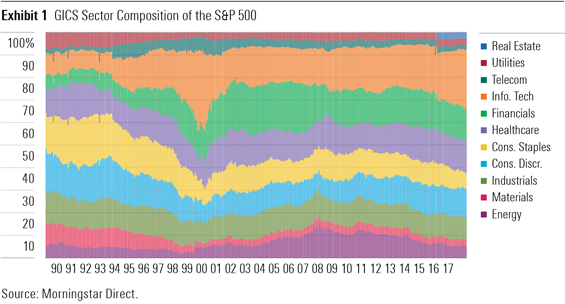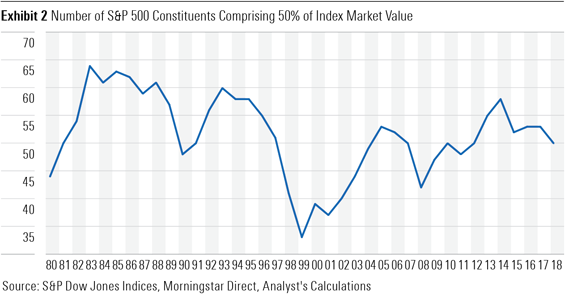Market-Cap Weighting's Greatest Strength Is Also Its Greatest Weakness
What many perceive as bugs in cap-weighting are actually a feature.
Market-capitalization-weighted indexing is a great strategy for many investors. But like any great strategy, it has experienced and will continue to experience periods where it looks like a bad idea. Here, I’ll look at what makes cap-weighting a sensible approach to building a stock portfolio and why its greatest strength can also be its greatest weakness. Given that we’ve lived through a decade-long stretch where cap-weighting has looked and felt brilliant, my hope is that this piece helps prepare disciples of owning the market to sit tight the next time it next looks and feels dimwitted.
Betting on Beta Market-cap-weighted stock index mutual funds and exchange-traded funds have grown tremendously in the 40-plus years since the launch of the Vanguard First Index Investment Trust. There are several explanations for this growth: Investors are becoming more fee-conscious, asset management and advice are being unbundled, disillusionment with active managers has grown, and so on. But I'd argue the common driver behind these funds' growth is the lasting appeal of the attributes of market-cap-weighted indexing as an investment strategy (as opposed to just a means of measuring market or manager performance). I'll treat the main ones here in turn.
Diversified
Market-cap-weighted stock indexes are generally well diversified. I say “generally” because they are not all created equal. For example, some single-country indexes may capture a narrow and shallow opportunity set. Classic examples include markets like Finland. Per MSCI data, the MSCI Finland Index had a total market cap of just $153.6 billion as of the end of August. The top five constituents of the index account for 68% of its value (
Furthermore, cap-weighted benchmarks’ degree of diversification may vary over time. In the go-go days of the Japanese stock market in the late 1980s, the MSCI EAFE Index at one point had 44% of its portfolio invested in Japanese equities. In the first quarter of 2000, the S&P 500 had 35% of its portfolio plugged into the bubbly tech sector. That said, funds underpinned by cap-weighted indexes nonetheless offer (varying degrees of) instant diversification.
It’s critical to understand that these cases reflect the core feature of market-cap indexing and are by no means a bug. In creating a cap-weighted benchmark, the opportunity set is what it is. There aren’t many large, liquid stocks in Finland, and Nokia just happens to be the largest among them. Also, market-cap-weighted indexes rely on the toil of others to set prices. They ride for free, leveraging the collective wisdom (or lack thereof) of other market participants, and take the prices that they are given. Thus, the degree of diversification they provide is a factor of the breadth and depth of the market in question and investors’ collective opinion on their constituents’ worth.
Inexpensive Market-cap weighting is an inexpensive approach to building a stock portfolio. Because cap-weighted indexes capture the collective effort spent by other investors figuring out fair prices, the funds that track them don't have to pay teams of portfolio managers and analysts to do the heavy lifting. Index-tracking funds' single-largest expense line item is the fee they pay to index providers for the privilege of using their intellectual property as the basis for a fund.
Cap-weighted indexes also tend to have very low levels of turnover. Any churn in the portfolio is typically a result of corporate actions (mergers, acquisitions, bankruptcies, and so on) or index additions and deletions (when stocks graduate to or are demoted from an index). Low turnover further reduces the cost profile of funds pegged to cap-weighted indexes.
Tax-Efficient Low turnover also lends itself to greater tax efficiency. The fewer stocks that are coming and going from the portfolio, the less likely it is that a fund will generate capital gains. I have spotlighted this topic before, so I won't belabor the point here.
Macro Representative
This is a fancy way of saying that cap-weighted indexes mirror the market. They reflect the opportunity set available to investors (U.S. large caps, emerging-markets stocks, Japanese small caps, and so on) and hold the stocks within that universe in accordance with their going market value. As such, this means that there is ample room, or capacity, for investors to allocate their money in this fashion. Any deviation from market-cap weighting will inherently reduce a strategy’s capacity. For example, going from weighting the S&P 500 by market cap, as is the case for
Proven Performance Market-cap-weighted indexes, and the funds that track them, have historically proved stiff competition for both active funds [1] and funds tracking non-cap-weighted indexes, [2]. But that's not to say that they've all done equally well, or that the best-performing ones haven't experienced rough patches along the way. As we've highlighted in these pages before and signal with our Morningstar Analyst Ratings for index mutual funds and ETFs, indexing is a better approach in some market segments than others. For example, we generally have a high opinion of cap-weighted index funds in U.S. large caps, we have a neutral stance in high-yield bonds; and we take a dim view on the approach within Canadian small caps.
Put to Good Use Not only have these funds generally performed well versus their peers, but investors have also tended to use them well—at least relatively speaking. I've documented this phenomenon over the past few years in my annual "Mind the Gap: Active Versus Passive Edition" study. In short, investors have tended to use index funds better than actively managed funds. Said differently, their behavior has been relatively less costly. I would attribute this in large part to differences in investor expectations within each camp. Buyers of active funds are hoping for something better than market performance. Buyers of cap-weighted index funds are content to match the market (minus a modest fee).
Not So Fast... What's not to love? A strategy that is diversified, inexpensive, tax-efficient and has loads of capacity, has performed well, and has been used well by investors? Sign me up!
The problem is that many of cap-weighting’s strengths are simultaneously its greatest weaknesses. As I’d mentioned earlier, cap-weighted indexes depend on input from the market to set prices. But the market can be moody, and sometimes it’s just plain wrong. The most meaningful example of this was the tech bubble. At the height of the market’s adoration of anything with “Internet” or “dot-com” in its name, cap weighting led to concentration. Exhibit 1 shows the evolution of the GICS sector composition of the S&P 500 since September 1989. Exhibit 2 shows the number of S&P 500 constituents that collectively represented 50% of the market cap of the index over the past 39 years. Both highlight just how extraordinarily wrong the market can be.


Batten the Hatches The recent narrowing of market leadership among a handful of technology and media giants and the resulting growth in sector- and stock-level concentration within the U.S. market has led many to draw parallels between the tech bubble and today. I think their arguments are tenuous at best, for the following reasons:
1. Valuations are nowhere near the insane levels they reached at the height of the tech bubble.
2. At the risk of repeating myself, concentration is a feature of cap-weighted indexes, not a bug.
3. By extension, it has been and forever will be the case that a minority of stocks will be responsible for most of the market’s gains.
That said, there will come a day when the market—and by extension, market-cap-weighted funds—will be proven foolish. It’s important to remember that this is a feature of the strategy that so many investors have subscribed to in recent years and not a flaw. As is the case with any strategy, knowing its features—as well as their flaws—and having the faith to stick with it matter more than anything else.
[1] Bryan, A. & Johnson, B. 2018. “Morningstar’s Active/Passive Barometer: Midyear 2018”. https://corporate1.morningstar.com/ ResearchLibrary/article/879075/morningstars-activepassive-barometer-midyear-2018-active-funds-success-rates-decline-in-the-years-first-half
[2] Johnson, B. 2017. “Have Strategic-Beta ETFs Delivered for Investors?”. https://www.morningstar.com/articles/816970/have-strategicbeta-etfs-delivered-for-investors.html
Disclosure: Morningstar, Inc. licenses indexes to financial institutions as the tracking indexes for investable products, such as exchange-traded funds, sponsored by the financial institution. The license fee for such use is paid by the sponsoring financial institution based mainly on the total assets of the investable product. Please click here for a list of investable products that track or have tracked a Morningstar index. Neither Morningstar, Inc. nor its investment management division markets, sells, or makes any representations regarding the advisability of investing in any investable product that tracks a Morningstar index.

/s3.amazonaws.com/arc-authors/morningstar/a90ba90e-1da2-48a4-98bf-a476620dbff0.jpg)
:quality(80)/cloudfront-us-east-1.images.arcpublishing.com/morningstar/T2LGZCEHBZBJJPPKHO7Y4EEKSM.png)
:quality(80)/cloudfront-us-east-1.images.arcpublishing.com/morningstar/HDPMMDGUA5CUHI254MRUHYEFWU.png)